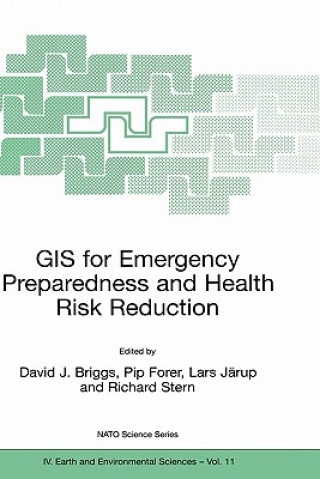
Kod: 01414910
GIS for Emergency Preparedness and Health Risk Reduction
Autor David J. Briggs, Pip Forer, Lars Järup, Richard Stern
Geographical Information Systems (GIS) have developed rapidly in recent years and now provide powerful tools for the capture, manipulation, integration, interrogation, modelling, analysis and visualisation of data - tools that are ... więcej
- Język:
 Angielski
Angielski - Oprawa: Twarda
- Liczba stron: 326
Wydawca: Springer-Verlag New York Inc., 2002
- Więcej informacji o książce

175.32 €

Dostępna u dostawcy w małych ilościach
Wysyłamy za 10 - 14 dni
Potrzebujesz więcej egzemplarzy?Jeżeli jesteś zainteresowany zakupem większej ilości egzemplarzy, skontaktuj się z nami, aby sprawdzić ich dostępność.
Dodaj do schowka
Zobacz książki o podobnej tematyce
-

50 Fantastic Things to Do with Paint
19.07 € -

Critical Issues in Systems Theory and Practice
226.30 € -

Artificial Neural Networks and Machine Learning -- ICANN 2012
57.84 € -

Expert Evidence and Criminal Justice
208.51 € -

Und Sagte Kein Einziges Wort
62.90 € -

Elements of Plane and Solid Geometry
41.93 € -

Technika Pracovný zošit pre 5. ročník ZŠ
6.25 € -28 %
Bon podarunkowy: Radość gwarantowana
- Podaruj bon o dowolnej wartości, a my się zajmiemy resztą.
- Bon podarunkowy dotyczy całej naszej oferty.
- Możesz wydrukować elektroniczny bon z e-maila a następnie przekazać go obdarowanemu.
- Ważność bonu wynosi 12 miesięcy od daty wystawienia.
Więcej informacji o GIS for Emergency Preparedness and Health Risk Reduction
Za ten zakup dostaniesz 446 punkty
 Opis
Opis
Geographical Information Systems (GIS) have developed rapidly in recent years and now provide powerful tools for the capture, manipulation, integration, interrogation, modelling, analysis and visualisation of data - tools that are already used for policy support in a wide range of areas at almost all geographic and administrative levels. This holds especially for emergency preparedness and health risk reduction, which are all essentially spatial problems. To date, however, many initiatives have remained disconnected and uncoordinated, leading to less powerful, less compatible and less widely implemented systems than might otherwise have been the case. §The important matters discussed here include the probabilistic nature of most environmental hazards and the semi-random factors that influence interactions between these and human exposures; the effects of temporal and spatial scales on hazard assessment and imputed risk; the effects of measurement error in risk estimation and the stratification of risks and their impacts according to socioeconomic characteristics; and the quantification of socioeconomic differences in vulnerability and susceptibility to environmental hazards.Geographical Information Systems (GIS) have developed rapidly in recent years and now provide powerful tools for the capture, manipulation, integration, interrogation, modelling, analysis and visualisation of data - tools that are already used for policy support in a wide range of areas at almost all geographic and administrative levels. This holds especially for emergency preparedness and health risk reduction, which are all essentially spatial problems. To date, however, many initiatives have remained disconnected and uncoordinated, leading to less powerful, less compatible and less widely implemented systems than might otherwise have been the case. §The important matters discussed here include the probabilistic nature of most environmental hazards and the semi-random factors that influence interactions between these and human exposures; the effects of temporal and spatial scales on hazard assessment and imputed risk; the effects of measurement error in risk estimation and the stratification of risks and their impacts according to socioeconomic characteristics; and the quantification of socioeconomic differences in vulnerability and susceptibility to environmental hazards. §GIS are powerful analytical tools in their own right, but what is needed is much more effective communication between the many disciplines, professions and stakeholders concerned - something which this book helps to achieve.
 Szczegóły książki
Szczegóły książki
Kategoria Książki po angielsku Medicine Medicine: general issues Public health & preventive medicine
175.32 €
- Pełny tytuł: GIS for Emergency Preparedness and Health Risk Reduction
- Autor: David J. Briggs, Pip Forer, Lars Järup, Richard Stern
- Język:
 Angielski
Angielski - Oprawa: Twarda
- Liczba stron: 326
- EAN: 9781402007989
- ISBN: 1402007981
- ID: 01414910
- Wydawca: Springer-Verlag New York Inc.
- Waga: 1450 g
- Wymiary: 235 × 155 × 25 mm
- Data wydania: 31. August 2002
Ulubione w innej kategorii
-

Glucose Revolution
15.69 € -19 % -

The Art & Science of Foodpairing
40.74 € -15 % -

Nutrition and Physical Degeneration
38.36 € -

Nutrition and Physical Degeneration
32.39 € -

Rewire Your Anxious Brain
17.78 € -9 % -

Gut
9.03 € -25 % -

Miller's Review of Critical Vaccine Studies
18.77 € -16 % -

Gordis Epidemiology
53.76 € -1 % -

Clever Guts Diet
11.12 € -28 % -

Yes, You Can Get Pregnant
15 € -23 % -

Nutritional Psychiatry
46.11 € -

Proteinaholic
13.61 € -12 % -

Vaccines, Autoimmunity, and the Changing Nature of Childhood Illness
18.97 € -28 % -

Falling in Love with Where You Are
20.96 € -9 % -

Gesundheit!
16.39 € -9 % -

Naturally Healthy Babies and Children
15.40 € -26 % -

Diet and Nutrition in Critical Care
1354.20 € -

Diseases of Wild Waterfowl
57.84 € -

Why We Eat (Too Much)
11.42 € -19 % -

China Study: Revised and Expanded Edition
16.39 € -9 % -

Encyclopedia of Bach Flower Therapy
28.61 € -18 % -

Neurosonology and Neuroimaging of Stroke
210 € -4 % -

Oxford Handbook of Clinical Medicine
59.92 € -

Energy Paradox
23.94 € -13 % -

Worry Trick
16.99 € -17 % -

Decision Modelling for Health Economic Evaluation
80.20 € -

Manual of Dietetic Practice 6e & Dietetic Case Studies Set
146.19 € -8 % -

Cure Tooth Decay
37.06 € -

It's All in Your Head
11.02 € -21 % -

Close Your Mouth
13.31 € -20 % -

Body Awareness as Healing Therapy
15 € -28 % -

Motivational Interviewing in Nutrition and Fitness
38.06 € -

Spillover
13.11 € -25 % -

Bio-identical Hormones and Telomerase
19.37 € -24 % -

Salt Fix
15 € -28 % -

Inner Level
10.62 € -24 % -

After Cancer Care
15 € -20 % -

Evidence-Based Medicine
42.13 € -3 % -

Causal Inference for Statistics, Social, and Biomedical Sciences
64.30 € -1 % -

Integrative and Functional Medical Nutrition Therapy
146.49 € -4 % -

Fortify Your Life
19.67 € -26 % -

Nutrition for Sport and Exercise - A Practical Guide
60.12 € -

Nutrition Essentials for Mental Health
46.11 € -6 % -

Nutrition for Sport, Fitness and Health
129.89 € -9 % -

Mikronährstoff-Räuber: Metformin
4.96 € -

Marijuana Medicine
31.60 € -4 % -

WHO classification of tumours of haematopoietic and lymphoid tissues
227.70 € -

Bella Figura
11.12 € -28 % -

Divided Mind
17.68 € -18 %
Osobní odběr Bratislava a 2642 dalších
Copyright ©2008-24 najlacnejsie-knihy.sk Wszelkie prawa zastrzeżonePrywatnieCookies


 Vrácení do měsíce
Vrácení do měsíce Zdarma od 49.99 €
Zdarma od 49.99 € 02/210 210 99 (8-15.30h)
02/210 210 99 (8-15.30h)